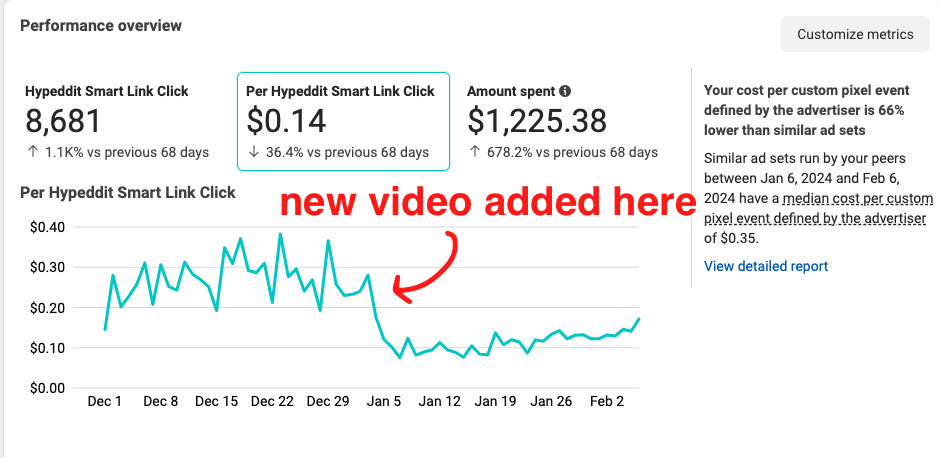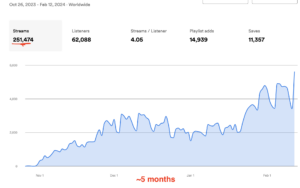I said “might,” okay? I’m still waffling, so don’t hold me to it.
Truth be told, I still don’t like short-form video content in general, and I like TikTok in particular even less. I’m old, I’m grumpy, and I’m set in my ways, kind of like Tom Cruise in Maverick except with less charisma and aerial combat skill.
Even so, after years of passive protest, I’m heavily considering giving the platform a try. I have two reasons:
First, I get asked about TikTok about three times as often as I floss.
(Don’t do the math but don’t worry, either. I’ve only had one cavity so far.)
Second, I’ve found that pretty much all of my most successful Meta ads clients regularly create short-form video content.
Given those two facts, I feel compelled to have something to say about the medium – and if I want what I say to be worthwhile, I think it should be founded on first-hand experience.
I don’t have any first-hand experience as a creator yet, so take the rest of this post with a grain of salt. But I still want to share how my most successful ads clients are using TikTok, because it’s leading to some pretty impressive results.
Here’s what the cool kids are doing.
1. The cool kids are using TikTok or Instagram Reels.
Or both.
(Also, I should clarify that when I say “cool kids,” I’m referring to my Meta ads clients who are getting the best results from their campaigns, not to Ryan Gosling or that very catchy song by Echosmith.)
There are a billion different approaches by which to make short-form video content – and the best-performing trends seem to fluctuate week by week – but whatever the angle they choose, the cool kids have this in common: they’re creating consistently.
“But how consistently?” you ask. “How often are they posting?”
You’re not alone; everyone asks this. The short answer is that my most successful clients are posting at least once or twice a week.
Not that bad, right? And yes, the longer answer is that the more frequently you can post, the better. If you post more often than you floss, you’re probably on the right track.
In terms of the actual content, again, things vary pretty widely. Most of my clients have at least tried some version of lip-syncing their songs; other than that, it depends on genre, personality, and comfort-level with pulling stunts in public.
As I said at the top of this, I’m not a creator myself, so take my advice with a grain of salt. But if you’re considering getting into the game, I’d recommend two things:
First, follow a bunch of accounts that are in a similar space to your own. If you’re an indie pop artist, follow indie pop artists. If you’re playing bluegrass, find some bluegrass creators. You get the idea – and yes, you can find creators in pretty much any genre, even the weird ones.
Following accounts will give you a good idea of what’s working in your space. Just make sure to limit how long you scroll.
Second, just start posting. This is really the key more than anything else – just go for stuff. Try recording yourself playing your own music live. Try playing covers. Try talking to the camera. Try making day-in-the-life content. Maybe don’t try that last one, because I find it pretty cringe. Maybe don’t care what I think and try it anyway.
And don’t worry if your videos suck. They probably will. The point is to give yourself at-bats; it’s the only way to figure out what will work for you.
(If you’re looking to learn more about the mindset behind short-form content creation from someone who’s actually done it, start with Nic D. Dude is killing it.)
Once you’re posting regularly, you’ll start collecting the fuel for good ad campaigns: data.
2. Learn from what works.
Each month, review your TikTok and Instagram accounts and see which videos performed the best. When you’re just starting out, sure, your numbers will be small – but the weird thing about these formats is that you can actually get decent reach right out of the gate, so you’ll probably have some data to look at.
Then put the data to use.
Organically, double down on what’s working (even if it’s only working a little). Test a few variations of the videos that performed the best. For example, if a lip-syncing video did well, try lip-syncing the same song in a different location. Or if that cover of Joni Mitchell got some love, try another one.
Another weird thing about TikTok is that you can kind of spam the same creative format and people won’t get annoyed; in fact, most of your followers might not even see it, and you’ll probably pull in new sets of eyes.
Ad-side, the strategy is pretty simple: Pull the videos with the most reach and engagement into your ad campaigns and put them to use.
Here’s what that can look like practically:

Those are clicks through to a song on Spotify.
Obviously, for the videos to work in ad campaigns, the content of the videos needs to align with whatever your ad campaign objectives are. But for most musicians, this happens pretty naturally. And hey, if a video doesn’t work in ads for some reason, just cut it from the campaign and pull in the next one.
To summarize:
The formula for the best ad campaigns is this:
1) Post short-form videos regularly (ideally more than once per week).
2) Pull the top performing videos into your ad campaigns each month.
3) Make more videos like the ones that worked.
Do that on repeat until you become Tai Verdes or TikTok goes the way of Vine – whichever comes first.
That’s my advice, anyway.
Now I just have to decide whether I’m too grumpy to follow it.









